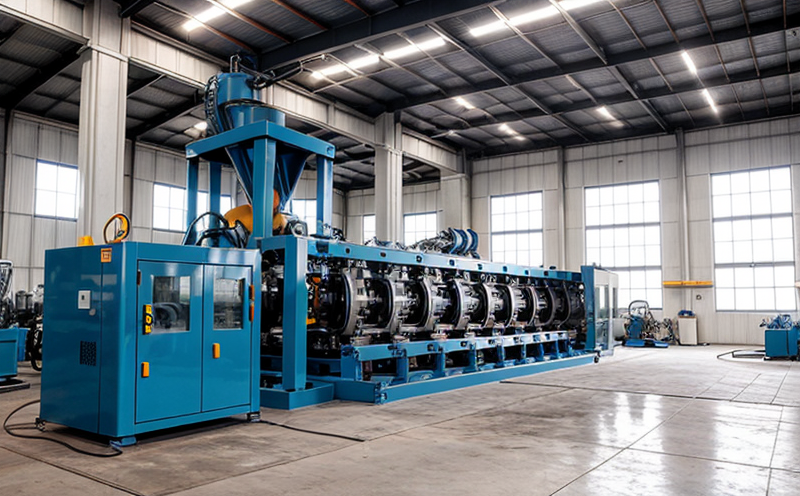ISO 10816 Mechanical Vibration Testing of Rotating Machinery
The ISO 10816 standard is a cornerstone in the field of rotating machinery diagnostics, providing guidelines for mechanical vibration testing. This service is essential for ensuring the reliability and safety of machinery used across industrial manufacturing processes. The primary focus lies on detecting potential faults early before they escalate into more serious issues that could lead to equipment failure or operational downtime.
The standard defines a structured approach to measuring vibrations in machines, which helps determine their health status by comparing it against predefined thresholds. By adhering strictly to these standards, manufacturers can maintain high levels of quality control and ensure compliance with international best practices. This service is particularly beneficial for organizations involved in heavy machinery production, power generation plants, automotive manufacturing units, and any industry where rotating equipment plays a crucial role.
The testing procedure involves several steps including proper setup of sensors on the machine being tested, calibration of instruments used during measurement, selection of appropriate frequency ranges based on the type of machine under inspection, and interpretation of results according to specified criteria. Compliance officers responsible for maintaining quality assurance programs will find this service invaluable in their efforts to uphold strict standards.
One key aspect highlighted by ISO 10816 is that vibration levels can indicate various types of faults within a rotating system such as misalignment, imbalance, looseness between components, or even bearing damage. Early detection allows for timely maintenance interventions reducing unnecessary costs associated with premature equipment failure. For quality managers and R&D engineers working closely with these systems, this service offers valuable insights into optimizing design parameters and improving overall performance.
From a technical perspective, the testing process typically begins by placing accelerometers or other suitable sensors at strategic locations around the machine to capture accurate data regarding its vibrational characteristics. These signals are then processed using specialized software tools designed specifically for analyzing mechanical vibrations. Once analyzed, these readings provide detailed information about the condition of the machinery which can be compared against established reference values found within ISO 10816.
Another important consideration when conducting this type of test is ensuring that all measurements adhere to specified frequency bands relevant to different parts of the machine's operation cycle. This ensures accurate representation of actual operating conditions so any anomalies detected are truly indicative of underlying problems rather than transient effects caused by external factors like ambient noise or temperature fluctuations.
Lastly, interpreting these results correctly forms another critical component of this service since even if high vibration levels are observed, not all cases necessarily require immediate intervention. A thorough understanding of the machine's operational context allows technicians to prioritize corrective actions based on their potential impact on production schedules and safety considerations.
Why It Matters
Compliance with ISO 10816 is crucial for several reasons, not least because it ensures that machinery used in industrial settings meets stringent quality standards set forth by international bodies. This helps protect consumers from potentially dangerous products while also fostering confidence among stakeholders involved throughout the supply chain.
- Reduces Downtime: By identifying issues early through vibration analysis, companies can schedule repairs during planned maintenance windows rather than experiencing unexpected outages that halt production lines.
- Promotes Safety: Detecting hazardous conditions like bearing failures or misalignments promptly prevents accidents and injuries among workers operating around such equipment.
- Enhances Reputation: Demonstrating adherence to global best practices enhances a company's reputation as a reliable partner for both domestic and international clients.
- Cost Efficiency: Preventative maintenance strategies enabled by this service can significantly reduce long-term operational costs associated with replacing damaged components or restoring functionality after failures occur.
In summary, ISO 10816 mechanical vibration testing serves as an indispensable tool for maintaining robust quality assurance processes in industrial environments. Its importance cannot be overstated given the far-reaching benefits it brings to both operators and end-users alike.
Industry Applications
The application of ISO 10816 mechanical vibration testing spans numerous industries where rotating machinery is integral to operations. Some notable sectors include:
- Power Generation: Ensuring the longevity and efficiency of turbines, generators, and other critical components.
- Aerospace & Defense: Vital for maintaining the integrity of engines, propellers, and other rotating parts in aircraft or spacecraft.
- Petrochemicals: Critical for monitoring pumps, compressors, and reactors used in refining processes.
- Automotive Manufacturing: Important for assessing engine performance during development stages as well as ensuring reliability post-production.
In each of these fields, consistent adherence to ISO 10816 guidelines ensures optimal performance while minimizing risks associated with mechanical failures. This makes it an indispensable service across diverse manufacturing and processing industries.
Competitive Advantage and Market Impact
- Enhanced Reputation: By demonstrating compliance with international standards like ISO 10816, companies can build trust among customers seeking reliable partners for their projects.
- Differentiation in Markets: Offering this specialized service positions firms ahead of competitors who may not prioritize such rigorous testing protocols.
- Potential for Growth: As awareness grows about the importance of predictive maintenance techniques, companies providing comprehensive vibration analysis services stand to gain from increased demand.
- Increased Client Loyalty: Satisfied clients who experience reduced downtime and improved machine performance are more likely to continue doing business with providers offering ISO 10816-compliant solutions.
The market for industrial machinery testing is expected to grow steadily as manufacturers increasingly recognize the value of proactive maintenance strategies. Those investing in cutting-edge technologies like vibration analysis will find themselves better equipped to meet future challenges and capitalize on emerging opportunities within this dynamic sector.





